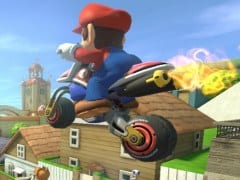Video Gamer is reader-supported. When you buy through links on our site, we may earn an affiliate commission. Prices subject to change. Learn more
We all know about the doom and gloom surrounding Nintendo’s ‘next-gen’ console. Instead of regurgitating the bleak picture that has been painted a million times, let’s focus on the fact that Nintendo still know how to make great games, and show as much with Mario Kart 8.
There have been some small but noticeable changes Kart veterans will quickly notice: you can no longer double up on items, and snaking continues to be nerfed thanks to narrow tracks and much tighter corners in greater frequency throughout most of the circuits. Being able to prep one item behind your kart as a defensive manoeuvre while grabbing another was a clever strategy for players out in front, but we’re now stuck with a single item until it’s released. Tracks also feel shorter – most can take less than a minute to get around – as long as you aren’t bombarded with items the whole way.
There are eight cups in total, split evenly between those dedicated to brand new tracks and revamped classics. Each circuit has four tracks, bringing the total to 32, but we only got to race around half of them. What we did get to drive on quickly entered my list of favourites. Even the renovated classic tracks feel fresh and new thanks to the tweaks to their layout, including underwater and new anti-gravity sections.
The anti-grav is present in pretty much every track, and while shoe-horned in some it feels excellent in others. Boo’s Mansion is a particular highlight, with a twisty-turny lap where karts can drive on pretty much any part of the house adding to the haunted house aesthetic. Toad’s Turnpike from Mario Kart 64 makes a return, and anti-gravity sections have been added to the side walls, meaning you can avoid the troublesome traffic for large parts of the race and take advantage of some handy speed boosts. My thoughts immediately turned to how amazing Rainbow Road would play with anti-grav littered across the track.
It’s only when I played some of the classic tracks that I was able to realise how much variety has been added to courses over the years. Mario Circuit 1 felt pretty dull in comparison, due to its entirely flat course barring a single jump in the centre.
This is also the best looking Mario Kart yet, as you would expect. All the tracks look amazing thanks to the vivid colour palette. One track in particular looks like it has been taken straight from Sugar Rush, the fictional game from Wreck-it Ralph.
You’ll be pleased to know that the GamePad now has functions beyond a simple car horn, too. Players can view the map of the track with live positions of all 12 racers, as well as off-screen play. The only downside is that, when playing split-screen multiplayer, the GamePad also shows a split-screen view, rather than your own race.
On the matter of split-screen, while Nintendo has acknowledged that the frame rate halves to 30 fps when three or more players play locally, the game feels like it struggles to keep up. The jittery nature of races makes it much more challenging to play with four players. There was no noticeable lag in control, but visually, it looked a mess.
But when you’re in a race, there’s never a dull moment. The only trouble I found was with the underwater sections: transitioning out of the water can be tricky as visibility is limited, thanks to both the ripples affecting the view of the track and the droplets on screen impeding your transition to dry land.
If, like me, you’ve become jaded by the lack of challenge in recent Mario Kart offerings, you’ll be pleased to know many of the new tracks offer greater difficulty, demanding an understanding of when to powerslide for the slalom corners, rather than flying around the whole lap at full speed. Boosting from powerslides takes a little longer to charge, too, and this coupled with tighter corners means you’ll have to earn every advantage.
Being knocked off track isn’t as much of a pain anymore either, as Lakitu catches you before falling completely out of the level and puts you back on the road within seconds, without the black load screen we’ve suffered every other time.
Sadly, the blue shell returns, but on the plus side it doesn’t seem as frequent as in previous games. In my time with the game twice per race was the maximum it would appear. While the blue shell was an annoyance, it was the green shell that proved to be more effective than in any other Mario Kart. Usually a throwaway item that proved of little use, its increased size makes it much more potent.
Bikes also make a return, and yes, they still suck. The customisation options of vehicles are as deep as they were on the DS and 3DS, and are the same across all characters. There are also ATV-esque karts that can survive better off-road.
Mario Kart 8 is still a couple of months away, but as a Wii U owner who hasn’t done much with his console other than blow the dust off from time to time, I can’t wait to pick this game up and start racing. For others planning on grabbing this game, do yourself a favour and choose Shy Guy immediately, his ‘thanks for choosing me’ celebratory noise will make him everyone’s new favourite character. Prepare for the year of Shy Guy.

/https://oimg.videogamer.com/images/91c4/mario_kart_8_40.jpg)
/https://oimg.videogamer.com/images/480b/mario_kart_8_33.jpg)
/https://oimg.videogamer.com/images/d45d/mario_kart_8_42.jpg)